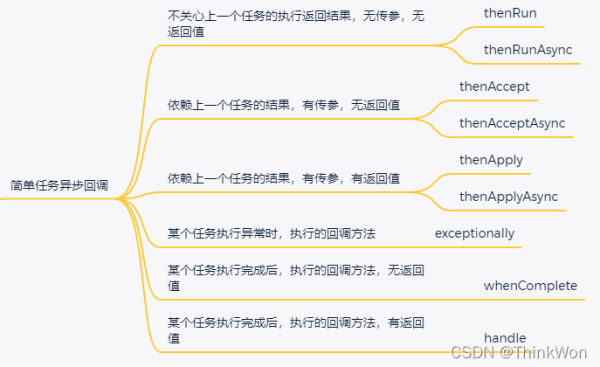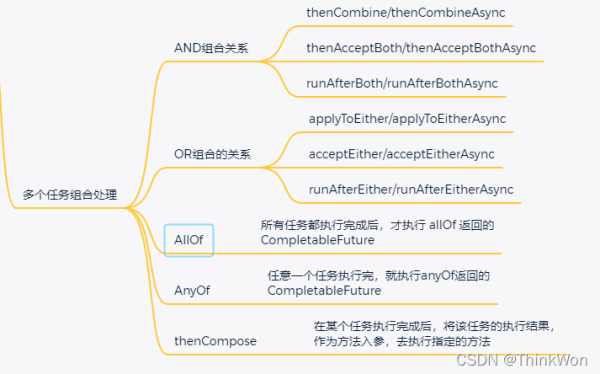这篇文章主要介绍了Java 8 的异步编程利器 CompletableFuture 详解,本文通过一个例子给大家介绍下Java 8 CompletableFuture异步编程的相关知识,需要的朋友可以参考下
最近刚好使用CompeletableFuture优化了项目中的代码,所以跟大家一起学习CompletableFuture

一个例子回顾 Future
因为CompletableFuture实现了Future接口,我们先来回顾Future吧
Future是Java5新加的一个接口,它提供了一种异步并行计算的功能。如果主线程需要执行一个很耗时的计算任务,我们就可以通过future把这个任务放到异步线程中执行。主线程继续处理其他任务,异步线程处理完成后,再通过Future获取计算结果
来看个简单例子吧,假设我们有两个任务服务,一个查询用户基本信息,一个是查询用户勋章信息。如下
public class UserInfoService { public UserInfo getUserInfo(Long userId) throws InterruptedException { Thread.sleep(300);//模拟调用耗时 return new UserInfo("666", "技术人成长之路", 27); //一般是查数据库,或者远程调用返回的 } } public class MedalService { public MedalInfo getMedalInfo(long userId) throws InterruptedException { Thread.sleep(500); //模拟调用耗时 return new MedalInfo("666", "守护勋章");接下来,我们来演示下,在主线程中是如何使用Future来进行异步调用的。
public class FutureTest { public static void main(String[] args) throws ExecutionException, InterruptedException { ExecutorService executorService = Executors.newFixedThreadPool(10); UserInfoService userInfoService = new UserInfoService(); MedalService medalService = new MedalService(); long userId =666L; long startTime = System.currentTimeMillis(); //调用用户服务获取用户基本信息 FutureTask userInfoFutureTask = new FutureTask<>(new Callable() { @Override public UserInfo call() throws Exception { return userInfoService.getUserInfo(userId); } }); executorService.submit(userInfoFutureTask); Thread.sleep(300); //模拟主线程其它操作耗时 FutureTask medalInfoFutureTask = new FutureTask<>(new Callable() { public MedalInfo call() throws Exception { return medalService.getMedalInfo(userId); executorService.submit(medalInfoFutureTask); UserInfo userInfo = userInfoFutureTask.get();//获取个人信息结果 MedalInfo medalInfo = medalInfoFutureTask.get();//获取勋章信息结果 System.out.println("总共用时" + (System.currentTimeMillis() - startTime) + "ms"); } } 运行结果:
总共用时806ms
如果我们不使用Future进行并行异步调用,而是在主线程串行进行的话,耗时大约为300+500+300 = 1100 ms。可以发现,future+线程池异步配合,提高了程序的执行效率。
但是Future对于结果的获取,不是很友好,只能通过阻塞或者轮询的方式得到任务的结果。
- Future.get() 就是阻塞调用,在线程获取结果之前get方法会一直阻塞。
- Future提供了一个isDone方法,可以在程序中轮询这个方法查询执行结果。
阻塞的方式和异步编程的设计理念相违背,而轮询的方式会耗费无谓的CPU资源。因此,JDK8设计出CompletableFuture。CompletableFuture提供了一种观察者模式类似的机制,可以让任务执行完成后通知监听的一方。
一个例子走进CompletableFuture
我们还是基于以上Future的例子,改用CompletableFuture 来实现
public class FutureTest { public static void main(String[] args) throws InterruptedException, ExecutionException, TimeoutException { UserInfoService userInfoService = new UserInfoService(); MedalService medalService = new MedalService(); long userId =666L; long startTime = System.currentTimeMillis(); //调用用户服务获取用户基本信息 CompletableFuture completableUserInfoFuture = CompletableFuture.supplyAsync(() -> userInfoService.getUserInfo(userId)); Thread.sleep(300); //模拟主线程其它操作耗时 CompletableFuture completableMedalInfoFuture = CompletableFuture.supplyAsync(() -> medalService.getMedalInfo(userId)); UserInfo userInfo = completableUserInfoFuture.get(2,TimeUnit.SECONDS);//获取个人信息结果 MedalInfo medalInfo = completableMedalInfoFuture.get();//获取勋章信息结果 System.out.println("总共用时" + (System.currentTimeMillis() - startTime) + "ms"); } } 可以发现,使用CompletableFuture,代码简洁了很多。CompletableFuture的supplyAsync方法,提供了异步执行的功能,线程池也不用单独创建了。实际上,它CompletableFuture使用了默认线程池是ForkJoinPool.commonPool。
CompletableFuture提供了几十种方法,辅助我们的异步任务场景。这些方法包括创建异步任务、任务异步回调、多个任务组合处理等方面。我们一起来学习吧
CompletableFuture使用场景

创建异步任务

CompletableFuture创建异步任务,一般有supplyAsync和runAsync两个方法
创建异步任务
- supplyAsync执行CompletableFuture任务,支持返回值
- runAsync执行CompletableFuture任务,没有返回值。
supplyAsync方法
//使用默认内置线程池ForkJoinPool.commonPool(),根据supplier构建执行任务 public static CompletableFuture supplyAsync(Supplier supplier) //自定义线程,根据supplier构建执行任务 public static CompletableFuture supplyAsync(Supplier supplier, Executor executor)
runAsync方法
//使用默认内置线程池ForkJoinPool.commonPool(),根据runnable构建执行任务 public static CompletableFuturerunAsync(Runnable runnable) //自定义线程,根据runnable构建执行任务 public static CompletableFuture runAsync(Runnable runnable, Executor executor)
实例代码如下:
public class FutureTest { public static void main(String[] args) { //可以自定义线程池 ExecutorService executor = Executors.newCachedThreadPool(); //runAsync的使用 CompletableFuture runFuture = CompletableFuture.runAsync(() -> System.out.println("run,技术人成长之路"), executor); //supplyAsync的使用 CompletableFuture supplyFuture = CompletableFuture.supplyAsync(() -> { System.out.print("supply,技术人成长之路"); return "技术人成长之路"; }, executor); //runAsync的future没有返回值,输出null System.out.println(runFuture.join()); //supplyAsync的future,有返回值 System.out.println(supplyFuture.join()); executor.shutdown(); // 线程池需要关闭 } } //输出 run,技术人成长之路 null supply,技术人成长之路技术人成长之路 任务异步回调

1. thenRun/thenRunAsync
public CompletableFuturethenRun(Runnable action); public CompletableFuture thenRunAsync(Runnable action);
CompletableFuture的thenRun方法,通俗点讲就是,做完第一个任务后,再做第二个任务。某个任务执行完成后,执行回调方法;但是前后两个任务没有参数传递,第二个任务也没有返回值
public class FutureThenRunTest { public static void main(String[] args) throws ExecutionException, InterruptedException { CompletableFuture orgFuture = CompletableFuture.supplyAsync( ()->{ System.out.println("先执行第一个CompletableFuture方法任务"); return "技术人成长之路"; } ); CompletableFuture thenRunFuture = orgFuture.thenRun(() -> { System.out.println("接着执行第二个任务"); }); System.out.println(thenRunFuture.get()); } } //输出 先执行第一个CompletableFuture方法任务 接着执行第二个任务 null thenRun 和 thenRunAsync 有什么区别呢?可以看下源码哈:
private static final Executor asyncPool = useCommonPool ? ForkJoinPool.commonPool() : new ThreadPerTaskExecutor(); public CompletableFuturethenRun(Runnable action) { return uniRunStage(null, action); } public CompletableFuture thenRunAsync(Runnable action) { return uniRunStage(asyncPool, action); }
如果你执行第一个任务的时候,传入了一个自定义线程池:
- 调用thenRun方法执行第二个任务时,则第二个任务和第一个任务是共用同一个线程池。
- 调用thenRunAsync方法执行第二个任务时,则第一个任务使用的是你自己传入的线程池,第二个任务使用的是ForkJoin线程池
TIPS:后面介绍的thenAccept和thenAcceptAsync,thenApply和thenApplyAsync等,它们之间的区别也是这个哈。
2.thenAccept/thenAcceptAsync
CompletableFuture的thenAccept方法表示,第一个任务执行完成后,执行第二个回调方法任务,会将第一个任务的执行结果,作为第二个任务的入参,传递到回调方法中,但是回调方法是没有返回值的。
public class FutureThenAcceptTest { public static void main(String[] args) throws ExecutionException, InterruptedException { CompletableFuture orgFuture = CompletableFuture.supplyAsync( ()->{ System.out.println("原始CompletableFuture方法任务"); return "技术人成长之路"; } ); CompletableFuture thenAcceptFuture = orgFuture.thenAccept((a) -> { if ("技术人成长之路".equals(a)) { System.out.println("关注了"); } System.out.println("先考虑考虑"); }); System.out.println(thenAcceptFuture.get()); } } 3. thenApply/thenApplyAsync
CompletableFuture的thenApply方法表示,第一个任务执行完成后,执行第二个回调方法任务,会将第一个任务的执行结果,作为第二个任务的入参,传递到回调方法中,并且回调方法是有返回值的。
public class FutureThenApplyTest { public static void main(String[] args) throws ExecutionException, InterruptedException { CompletableFuture orgFuture = CompletableFuture.supplyAsync( ()->{ System.out.println("原始CompletableFuture方法任务"); return "技术人成长之路"; } ); CompletableFuture thenApplyFuture = orgFuture.thenApply((a) -> { if ("技术人成长之路".equals(a)) { return "关注了"; } return "先考虑考虑"; }); System.out.println(thenApplyFuture.get()); } } //输出 原始CompletableFuture方法任务 关注了 4. exceptionally
CompletableFuture的exceptionally方法表示,某个任务执行异常时,执行的回调方法;并且有抛出异常作为参数,传递到回调方法。
public class FutureExceptionTest { public static void main(String[] args) throws ExecutionException, InterruptedException { CompletableFuture orgFuture = CompletableFuture.supplyAsync( ()->{ System.out.println("当前线程名称:" + Thread.currentThread().getName()); throw new RuntimeException(); } ); CompletableFuture exceptionFuture = orgFuture.exceptionally((e) -> { e.printStackTrace(); return "你的程序异常啦"; }); System.out.println(exceptionFuture.get()); } } //输出 当前线程名称:ForkJoinPool.commonPool-worker-1 java.util.concurrent.CompletionException: java.lang.RuntimeException at java.util.concurrent.CompletableFuture.encodeThrowable(CompletableFuture.java:273) at java.util.concurrent.CompletableFuture.completeThrowable(CompletableFuture.java:280) at java.util.concurrent.CompletableFuture$AsyncSupply.run(CompletableFuture.java:1592) at java.util.concurrent.CompletableFuture$AsyncSupply.exec(CompletableFuture.java:1582) at java.util.concurrent.ForkJoinTask.doExec(ForkJoinTask.java:289) at java.util.concurrent.ForkJoinPool$WorkQueue.runTask(ForkJoinPool.java:1056) at java.util.concurrent.ForkJoinPool.runWorker(ForkJoinPool.java:1692) at java.util.concurrent.ForkJoinWorkerThread.run(ForkJoinWorkerThread.java:157) Caused by: java.lang.RuntimeException at cn.eovie.future.FutureWhenTest.lambda$main$0(FutureWhenTest.java:13) at java.util.concurrent.CompletableFuture$AsyncSupply.run(CompletableFuture.java:1590) ... 5 more 你的程序异常啦 5. whenComplete方法
CompletableFuture的whenComplete方法表示,某个任务执行完成后,执行的回调方法,无返回值;并且whenComplete方法返回的CompletableFuture的result是上个任务的结果。
public class FutureWhenTest { public static void main(String[] args) throws ExecutionException, InterruptedException { CompletableFuture orgFuture = CompletableFuture.supplyAsync( ()->{ System.out.println("当前线程名称:" + Thread.currentThread().getName()); try { Thread.sleep(2000L); } catch (InterruptedException e) { e.printStackTrace(); } return "技术人成长之路"; } ); CompletableFuture rstFuture = orgFuture.whenComplete((a, throwable) -> { System.out.println("当前线程名称:" + Thread.currentThread().getName()); System.out.println("上个任务执行完啦,还把" + a + "传过来"); if ("技术人成长之路".equals(a)) { System.out.println("666"); } System.out.println("233333"); }); System.out.println(rstFuture.get()); } } //输出 当前线程名称:ForkJoinPool.commonPool-worker-1 当前线程名称:ForkJoinPool.commonPool-worker-1 上个任务执行完啦,还把技术人成长之路传过来 666 233333 技术人成长之路 6. handle方法
CompletableFuture的handle方法表示,某个任务执行完成后,执行回调方法,并且是有返回值的;并且handle方法返回的CompletableFuture的result是回调方法执行的结果。
public class FutureHandlerTest { public static void main(String[] args) throws ExecutionException, InterruptedException { CompletableFuture orgFuture = CompletableFuture.supplyAsync( ()->{ System.out.println("当前线程名称:" + Thread.currentThread().getName()); try { Thread.sleep(2000L); } catch (InterruptedException e) { e.printStackTrace(); } return "技术人成长之路"; } ); CompletableFuture rstFuture = orgFuture.handle((a, throwable) -> { System.out.println("上个任务执行完啦,还把" + a + "传过来"); if ("技术人成长之路".equals(a)) { System.out.println("666"); return "关注了"; } System.out.println("233333"); return null; }); System.out.println(rstFuture.get()); } } //输出 当前线程名称:ForkJoinPool.commonPool-worker-1 上个任务执行完啦,还把技术人成长之路传过来 666 关注了 多个任务组合处理

AND组合关系

thenCombine / thenAcceptBoth / runAfterBoth都表示:将两个CompletableFuture组合起来,只有这两个都正常执行完了,才会执行某个任务。
区别在于:
- thenCombine:会将两个任务的执行结果作为方法入参,传递到指定方法中,且有返回值
- thenAcceptBoth: 会将两个任务的执行结果作为方法入参,传递到指定方法中,且无返回值
- runAfterBoth:不会把执行结果当做方法入参,且没有返回值。
public class ThenCombineTest { public static void main(String[] args) throws InterruptedException, ExecutionException, TimeoutException { CompletableFuture first = CompletableFuture.completedFuture("第一个异步任务"); ExecutorService executor = Executors.newFixedThreadPool(10); CompletableFuture future = CompletableFuture //第二个异步任务 .supplyAsync(() -> "第二个异步任务", executor) // (w, s) -> System.out.println(s) 是第三个任务 .thenCombineAsync(first, (s, w) -> { System.out.println(w); System.out.println(s); return "两个异步任务的组合"; }, executor); System.out.println(future.join()); executor.shutdown(); } } //输出 第一个异步任务 第二个异步任务 两个异步任务的组合 OR组合的关系

applyToEither / acceptEither / runAfterEither 都表示:将两个CompletableFuture组合起来,只要其中一个执行完了,就会执行某个任务。
区别在于:
- applyToEither:会将已经执行完成的任务,作为方法入参,传递到指定方法中,且有返回值
- acceptEither: 会将已经执行完成的任务,作为方法入参,传递到指定方法中,且无返回值
- runAfterEither:不会把执行结果当做方法入参,且没有返回值。
public class AcceptEitherTest { public static void main(String[] args) { //第一个异步任务,休眠2秒,保证它执行晚点 CompletableFuture first = CompletableFuture.supplyAsync(()->{ try{ Thread.sleep(2000L); System.out.println("执行完第一个异步任务");} catch (Exception e){ return "第一个任务异常"; } return "第一个异步任务"; }); ExecutorService executor = Executors.newSingleThreadExecutor(); CompletableFuture future = CompletableFuture //第二个异步任务 .supplyAsync(() -> { System.out.println("执行完第二个任务"); return "第二个任务";} , executor) //第三个任务 .acceptEitherAsync(first, System.out::println, executor); executor.shutdown(); } } //输出 执行完第二个任务 第二个任务 AllOf
所有任务都执行完成后,才执行 allOf 返回的CompletableFuture。如果任意一个任务异常,allOf的CompletableFuture,执行get方法,会抛出异常
public class allOfFutureTest { public static void main(String[] args) throws ExecutionException, InterruptedException { CompletableFuture a = CompletableFuture.runAsync(()->{ System.out.println("我执行完了"); }); CompletableFuture b = CompletableFuture.runAsync(() -> { System.out.println("我也执行完了"); }); CompletableFuture allOfFuture = CompletableFuture.allOf(a, b).whenComplete((m,k)->{ System.out.println("finish"); }); } } //输出 我执行完了 我也执行完了 finish AnyOf
任意一个任务执行完,就执行anyOf返回的CompletableFuture。如果执行的任务异常,anyOf的CompletableFuture,执行get方法,会抛出异常
public class AnyOfFutureTest { public static void main(String[] args) throws ExecutionException, InterruptedException { CompletableFuture a = CompletableFuture.runAsync(()->{ try { Thread.sleep(3000L); } catch (InterruptedException e) { e.printStackTrace(); } System.out.println("我执行完了"); }); CompletableFuture b = CompletableFuture.runAsync(() -> { System.out.println("我也执行完了"); }); CompletableFuture thenCompose
thenCompose方法会在某个任务执行完成后,将该任务的执行结果,作为方法入参,去执行指定的方法。该方法会返回一个新的CompletableFuture实例
- 如果该CompletableFuture实例的result不为null,则返回一个基于该result新的CompletableFuture实例;
- 如果该CompletableFuture实例为null,然后就执行这个新任务
public class ThenComposeTest { public static void main(String[] args) throws ExecutionException, InterruptedException { CompletableFuture f = CompletableFuture.completedFuture("第一个任务"); //第二个异步任务 ExecutorService executor = Executors.newSingleThreadExecutor(); CompletableFuture future = CompletableFuture .supplyAsync(() -> "第二个任务", executor) .thenComposeAsync(data -> { System.out.println(data); return f; //使用第一个任务作为返回 }, executor); System.out.println(future.join()); executor.shutdown(); } } //输出 第二个任务 第一个任务 CompletableFuture使用有哪些注意点
CompletableFuture 使我们的异步编程更加便利的、代码更加优雅的同时,我们也要关注下它,使用的一些注意点。

1. Future需要获取返回值,才能获取异常信息
ExecutorService executorService = new ThreadPoolExecutor(5, 10, 5L, TimeUnit.SECONDS, new ArrayBlockingQueue<>(10)); CompletableFuturefuture = CompletableFuture.supplyAsync(() -> { int a = 0; int b = 666; int c = b / a; return true; },executorService).thenAccept(System.out::println); //如果不加 get()方法这一行,看不到异常信息 //future.get();
Future需要获取返回值,才能获取到异常信息。如果不加 get()/join()方法,看不到异常信息。小伙伴们使用的时候,注意一下哈,考虑是否加try…catch…或者使用exceptionally方法。
2. CompletableFuture的get()方法是阻塞的
CompletableFuture的get()方法是阻塞的,如果使用它来获取异步调用的返回值,需要添加超时时间~
//反例 CompletableFuture.get(); //正例 CompletableFuture.get(5, TimeUnit.SECONDS);
3. 默认线程池的注意点
CompletableFuture代码中又使用了默认的线程池,处理的线程个数是电脑CPU核数-1。在大量请求过来的时候,处理逻辑复杂的话,响应会很慢。一般建议使用自定义线程池,优化线程池配置参数。
4. 自定义线程池时,注意饱和策略
CompletableFuture的get()方法是阻塞的,我们一般建议使用future.get(3, TimeUnit.SECONDS)。并且一般建议使用自定义线程池。
但是如果线程池拒绝策略是DiscardPolicy或者DiscardOldestPolicy,当线程池饱和时,会直接丢弃任务,不会抛弃异常。因此建议,CompletableFuture线程池策略最好使用AbortPolicy,然后耗时的异步线程,做好线程池隔离哈。
到此这篇关于Java 8 的异步编程利器 CompletableFuture 详解的文章就介绍到这了,更多相关Java 8 CompletableFuture异步编程内容请搜索0133技术站以前的文章或继续浏览下面的相关文章希望大家以后多多支持0133技术站!
以上就是Java 8 的异步编程利器 CompletableFuture的实例详解的详细内容,更多请关注0133技术站其它相关文章!







